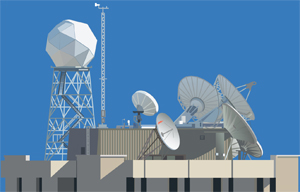 |
Director's NoteFred Best |
This month I would like to call out a very significant achievement by SSEC’s Ice Drilling Design and Operations (IDDO) group who, develop, deploy, and provide operational support throughout the world for the NSF Office of Polar Programs.
Deep within ice sheets in the Polar Regions is an archive of evidence about the climate of the past. Ice cores drilled in the past have yielded amazing scientific discoveries, for example that climate can change abruptly in less than ten years, and that the CO2 in the atmosphere now is higher than evidence from the last 800,000 years. At the WAIS Divide site, a cold area of the West Antarctic Ice Sheet where the abundant snowfall rarely melts, the ice contains many tens of thousands of years of annual information about past climate. At specific depths in the ice sheet, including from times of abrupt climate change in the past, scientists are investigating past greenhouse gas records and other evidence from the ice that will help to understand why and how abrupt changes occur.
Now, for the first time, significant innovations by the IDDO team are providing scientists with replicate ice cores from targeted depths and directions in the ice sheet. The newly developed, state-of-the-art Replicate Coring System is capable of retrieving additional ice cores from specific depths on the uphill side and parallel to the main borehole.
The Replicate Coring technique was developed and tested by the IDDO engineers as part of the DISC Drill. The design of the DISC Drill was started by the IDDO team in 2002 in response to the desire of the US science community for a deep coring drill that would incorporate the ability to retrieve additional cores from deviations from the main borehole. The DISC Drill was put into service at WAIS Divide during the 2007-08 Antarctic field season and completed the main borehole during 2011- 12 reaching a depth of 3,405 meters – an American record. Testing of the replicate coring system began at the end of the 2011-12 season, and helped identify several design issues related to drill stiffness and cutting geometry and technique that were successfully addressed during a very compressed off-season.
Jay Johnson, the Lead Drilling Engineer for the endeavor says “There was a bit of uncertainty after we drilled the first replicate core weather we had actually recovered it in the core barrel. After waiting a half hour for the drill to return to the surface from 3002.6m, the drill team and core handlers assembled in the drill arch were dead silent as we watched the drill tower tilt and waited for the first glimpse into the drill head. A loud cheer erupted at the sight of the core! It was a surreal moment for the drill team and especially for the IDDO engineers, Nicolai Mortensen, Chris Gibson, and myself, who developed the technology and hardware for the world’s first robotic ice coring drill. This is truly an engineering marvel and a new chapter in ice core drilling that will lead to new scientific discoveries.“
“A stupendous accomplishment! The IDDO engineers have succeeded at a feat that presented many difficulties, all of which they have overcome by dedication, ingenuity, skill, and just plain hard work. They have broken new ground in the ice coring business with the first directed deviation from a main borehole with a suspended electromechanical drill. This opens a new door for the future of ice core drilling. Our heartiest congratulations go to the whole IDDO crew at WAIS Divide,” says Charlie Bentley, the P.I. of IDDO.
“The realization of replicate coring at WAIS Divide has been the result of a lot of ingenuity and hard work by the staff of IDDO. The success of effort to retrieve replicate cores was far from certain and was only possible because of the interest and confidence in the project and IDDO shown by Julie Palais the NSF Program Manager, and Chief Scientist for the WAIS Divide project Kendrick Taylor, Lead Scientist for Replicate Coring Jeff Severinghaus, and numerous other scientists interested in ice cores," said Don Lebar, IDDO Program director.
“The Replicate Coring success is the result of a long journey in engineering development, working toward the attainment of very aggressive and sometimes seemingly impossible goals,” says Alex Shturmakov, DISC/Replicate Coring Project Manager of IDDO.
On-site drilling operations at the WAIS divide are led by Jay Johnson and Kristina Dahnert. Other IDDO staff providing support on the ice include:
Patrick Cassidy
Dave Ferris
Chris Gibson
Jason Goetz
Josh Goetz
Mike Jayred
Nicolai Mortensen
Elizabeth Morton
Tanner Kuhl
Congratulations to the IDDO team for a racking up another tremendous accomplishment.
Check out an excellent video describing the Replicate Drill and take a 2 mile journey under the Antarctic Ice!

